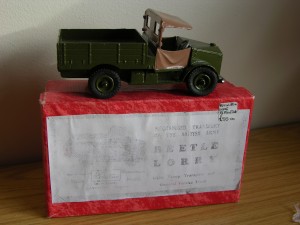During the 1930s the British Army approached the British motor industry with requirements for a lightweight truck. By 1935 Commer had produced 2 prototypes and after a very short Army trial an order for nearly 500 vehicles was placed for a vehicle that became known as the Beetle, a light weight Army work horse conceived long before the Land Rover was invented. It took Britains a further five years to produce their own version of the model, which they made both pre & post war making a big difference to the model value, below are the subtle differences:
Pre war version
Khaki matt paint finish
Solid lead
White solid rubber tyres
Cabin tilt & door screens in lighter khaki paint shade to simulate canvas
No windscreen or side windows
No tow hook
Hood/tilt with 2 removable rectangular rear viewing slits
Moulded leather style front seats
Driver wearing shrapnel helmet
4 spoke steering wheel in unpainted lead
Vertical radiator with 2 silver painted headlights
Front bumper only, painted cream
2 bench seats moulded into the rear
Underside modelling includes exhaust pipe & transmission
Post war version
Darker gloss green paint finish
Black plastic tyres
Rear moulded floor looks simulating timber
Tow hook
Post war it continued with the reference no.1877 but was incorporated into Set no. 2048 along with a Trailer (no. 2041) and 25 Pounder Gun (no. 2026)












